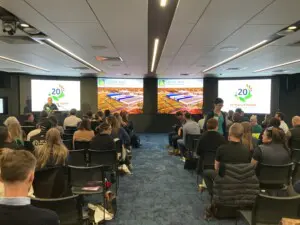 Revegetation – bringing plants into an area again – is complex and essential. Naturally, this is no surprise to anyone in the seeding, rehabilitation and ecology industry, but for some of us, the last time we thought about seeds was when purchasing grapes.
Revegetation – bringing plants into an area again – is complex and essential. Naturally, this is no surprise to anyone in the seeding, rehabilitation and ecology industry, but for some of us, the last time we thought about seeds was when purchasing grapes.
I’ve been to a lot of conferences in my time, but mingling with environmental scientists speaking Latin was a first. The Revegetation Industry Association of Western Australia (RIAWA) held its two-yearly conference last week, a huge 20th anniversary event.
As a valued partner of CRC TiME, RIAWA’s ability to gather the right people in the room is unparalleled, and it was particularly wonderful to see many other CRC TiME partners – from farmers, to mining professionals, to local government and NGO bodies – sharing their expertise with each other for positive environmental outcomes. Current Chairperson Damian Grose is representing RIAWA working with CRC TiME on a project led by CSIRO’s Dr Rebecca Jordan, involving experiments at four mine sites to compare local vs alternative climate-adapted seed-sourcing approaches.
Between online-searching Latin names for plants I may have recognised on various bushwalks (‘Oh, THAT one!’), spatially locating regional areas on online maps, and peering at before and after photos of landscapes, I came out with a greater sense of connection to my surroundings. South-west Western Australia is truly an eco hotspot with exciting past, current and future restoration projects.
Here’s some of what surprised, fascinated and stopped me in my tracks.
1. Everyone has a part to play
What became abundantly clear was the many people it takes to restore an area. From collectors sourcing the seeds, to nursery staff who grow tube stock under careful conditions (sometimes imitating natural harsh landscapes to ‘toughen up’ the plants), there are those who catalogue seeds and plants, storehouse staff, regulators and policy advisors, researchers and lab technicians, industry environmental professionals, and plenty more.
The public has a role in encouraging thriving natural environments by sticking to marked paths in reveg sites and advocating for policy change and political interest in local areas. Reveg is also essential to meeting the increasing public expectations of mine site rehabilitation – in order to keep its social licence, the mining industry needs to publicly show its commitment to rehabilitating land. The Beenup case study is just one example.
2. There’s a big difference between revegetation and restoration
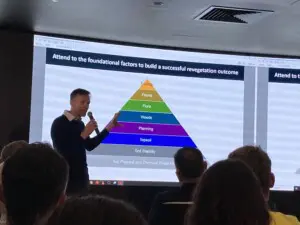
Dr Mark Dobrowlski from Iluka explaining factors affecting reveg outcomes.
Revegetation itself can be relatively simple: to revegetate an area, plant one type of tree or bush in a row and boom, you’ll grow something. But what you’re left can be closer to a Christmas Tree farm than an ecosystem buzzing with insects and biodiversity.
Bush Heritage Australia’s Alex Hams spoke of the need for high quality restoration, with an increasing need to sequester carbon. The Nature Repair Market Bill was introduced to federal Parliament in late March 2023; if it passes, Australia will have first voluntary biodiversity market in the world.
Dr Lucy Commander at Alcoa made the sage point that lack of ecological diversity tells us much about how things are going in an area, and where it falls between pine plantation and reference ecosystem. Positive ecological restoration is where we need to land after a mine closes.
3. People working within ecological restoration are passionate and progressive, and we owe them a lot
My first chat as I was pinning my nametag to my jacket was with Glen Mountford, Rehabilitation Officer at Talison Lithium, and a tried-and-true seed collector. He patiently explained that seed collectors each hold licences to pick in various areas. It’s a careful craft, he said, taking care of boodja (Country), ensuring they don’t take too much or too often, that they’re aware of market needs, and work alongside seasons, fire and flood.
Conference delegates – Glen’s colleagues across various organisations – reflected his love for the earth, his dedication to following the latest science, and to both restoring and nurturing balance in nature. The RIAWA community is kind, deeply knowledgeable, and generous with their time and expertise.
4. Topsoil is a sort of black gold on which everyone relies
There was much talk about topsoil. What to do with it, how long to do it for, where to put it, what to put in it.
Dr Peter Golos from Kings Park Science explained that the success of restoring vegetation to mine sites is highly dependent on the substrate used to reconstruct the soil profile. You need to consider the topsoil and mine waste, among other things. I learned not only is topsoil important, but there’s topoil… and then there’s the top of the topsoil. Dr Golos suggests topsoil should be harvested when conditions are dry, and it should also be stockpiled dry. Soil should be double-stripped, meaning the first 10cm (where the soil seedbank is) be taken first and kept separate to the rest of the soil below.
Side note: coating seeds in chilli can help prevent rodent predation!
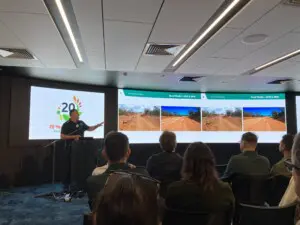
Nigel Rowe from Main Roads showing us before and after road reveg.
5. Carefully planned revegetation happens often, and in a lot of places, without most of us knowing
Restoration – when done well – happens without most of us realising. Hearing from Nigel Rowe at Main Roads, it turns out that drilling holes or cracks into an old road and planting tube stock directly into the gap could limit the weeds growing around it (we’ll get to the problem of weeds later).
If you’ve ever been to Augusta Boat Harbour in south-west WA, you most likely took for granted the thriving bushland where the area has been carefully restored with coastal native seeds sourced from Shire Reserves at Cape Leeuwin: 55 plant taxa were collected, resulting in over 22kgs of seeds. Kennedia lateritia, a little red flowering climber, is an endangered species endemic to this area. The rehabilitation work carefully avoided each and every plant; the species has now established prolifically in the area.
Of course, ecological restoration is also a key to post-mine revegetation, including of older mine sites. Dr Lucy Commander from Alcoa explained the importance of long-term monitoring of mine rehabilitation, in particular adaptive management and how to measure success. Alcoa stores about three years’ worth of seed stock: enough inventory to ensure enough seed is ready when it’s not available through usual means.
Planning and efficiency is key. Alcoa, UWA and DBCA are also working with CRC TiME (and led by Dr Todd Erickson) on the Australian Seed Scaling Initiative, focussed on increasing the efficiency of seed performance in ecosystem rehabilitation for mined and agricultural landscapes.
6. Weeds pose a real difficulty
Everyone mentioned weeds: not only is land sown or replanted, but weeds need to be managed. Decisions are made whether to use certain chemicals, whether cutting or pulling out by hand – shout-out to the community groups hand-planting and hand-weeding their revegetated areas.
In the rehabilitation process, topsoil full of weeds often needs to be disposed of by burying it deep underground where the seeds won’t germinate. Rehabilitated land with weeds needs to be managed – seeding a weedy area likely means your energy goes to waste.
7. How you collect, store and sow a seed will strongly affect its germination
Provenance zones and genetics are crucial to choosing strong seed, as well as storing it correctly. Good record-keeping is important – trials are conducted to test seed viability, and upon receiving the results, seed mixes are recalibrated accordingly. The goal, of course, is to have species that are adaptable, not just for now but into the future.
Working with seed, Matthew Wood from Natural Area explains that some questions need to be asked when considering growing diversity, particularly with recalcitrant plants that are stubborn, not commonly produced and hard to bring into the ecosystem: is seed available? How does it grow in the wild? Is it viable?
Dr Simone Pedrini, postdoctoral researcher at Curtin University, spoke on protocols and methodology for quality testing of seeds. He’s also working closely with the ARC Training Centre for Healing Country (more on them later) on Indigenous-led restoration. Syntheses everywhere!
Dr Shane Turner, also from Curtin, said characterising key biological and ecological seed traits aids and enhances restoration. He’s previously worked on the five-year Restoration Seedbank Initiative (RSB) with BHP, UWA and Kings Park Science but since 2020 has been with the Centre for Mine Site Restoration at Curtin University. Understanding seed mass is crucial to sowing practices: small seeds like Melaleuca seeds are much harder to sow using mechanised approaches, and sowing depth matters because small seeds cannot emerge if they’re sown too deeply.
For some Pilbara species, around 20% cannot emerge more than 20mm below the soil. Too deep = no plant. The common approach – to sow directly on the soil surface – is also not necessarily the best way, as seeds lying on the ground are prone to wind, predation, desiccation and temperature extremes. The best germination is around 10mm sowing depth – seeds perform better under the soil, but not too deep.
Also, given the right conditions, species in the Pilbara and Kimberley rocket out of the soil compared to species in the south-west (for instance, Gnangara on the Swan Coastal Plain). South-west WA species have slow germination rates and quite specific temperature requirements, an important consideration for post-mine rehabilitation work in WA mining regions, for instance.
8. Research should be kept open access
Having the latest findings – fewer than five years old – will ensure science is communicated to end users. Organisations like RIAWA and CRC TiME share information via databases, standards and systems; check out the latest research on mine closure, rehabilitation and post-mine land uses, either in fact sheet, case study or full research project report form, or through our searchable e-library.
9. Bees are an ecologist’s best friend, but pollination requires bee-champions
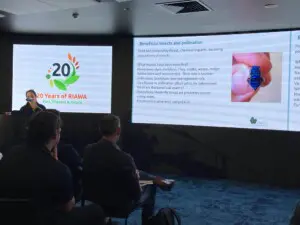
Linda Metz from the South West Catchments Council talking about native (blue!) bees.
Linda Metz at the South-West Catchment Council shared her thoughts on boosting pollinators to build resilience-revegetation for productivity and biodiversity. She encourages farmers in south-west WA to use natural vegetation to enhance their farming practices by showing farmers why it will help them.
The Council has produced fruiting and flowering calendars to encourage a seasonal understanding of pollination and is increasingly bringing farmers and Traditional Owners together to develop relationships and build cultural knowledge into agricultural practices.
10. Growth – real, diverse, sustainable growth – takes time
Interestingly, Damian Grose from Tranen spoke about the Port Bouvard East Port project, 20 years on, and reiterated the need to spend at least three years maintaining a revegetated site before handing over and calling the project completed.
This was a widely-agreed point among conference delegates: while planting a single species of pine in rows is easy enough, generating true ecological restoration through a diversity of species is a years-long process that can neither be hurried, nor shortened. Dr Andrew Knight from the ARC Training Centre for Healing Country highlighted the history and continued importance of Indigenous land management practices, encouraging a cross-cultural space for applied researchers in the restoration economy. As the first Indigenous-focussed and Indigenous-led centre of its kind, he noted the ‘biocultural’ dimension to landscape restoration, and highlighted Indigenous notions of the circularity of time as opposed to the linear, fast-paced, often culturally insensitive ways of working in the wadjela model. Christian Miller-Sabbioni, Veronica Goerke, Mandy Downing and Professor Stephen van Leeuwen from Healing Country and Curtin University delved into time as one of the foundations for effective Indigenous inclusion.
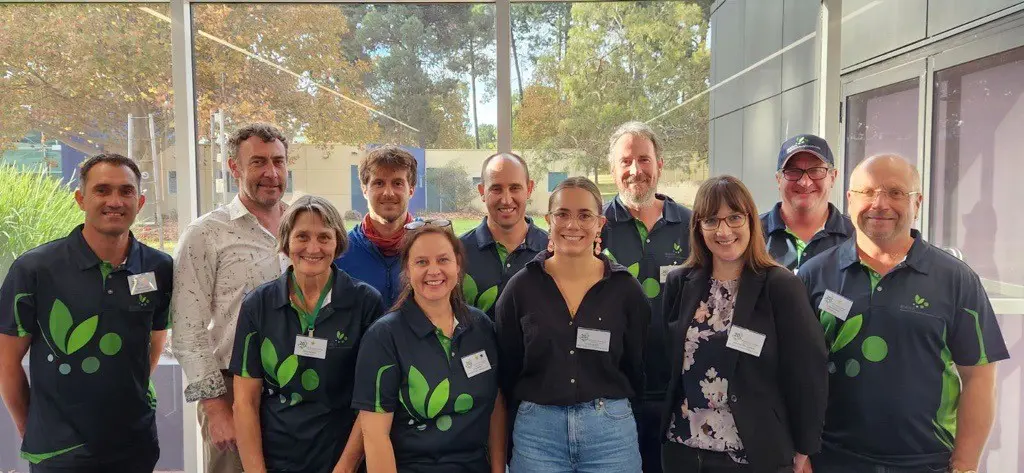
The ARC Training Centre for Healing Country staff together with RIAWA committee members and conference organisers.
Looking forward to the next RIAWA conference in a couple of years. In the meantime, we’ll continue our contribution at CRC TiME through our project collaborations across our multiple programs. Get in touch if you have a burning restoration question that might need some research.
—Dr Rebecca Rey, Communications Manager, CRC TiME

